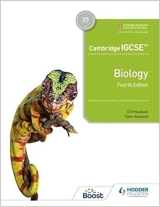Chapter 7. Transport in plants
Page 60
1.The water molecule enters the root hair cell, passes through the root cortex to reach a vessel in the vascular bundle. It is carried up the vessel in the stem by the transpiration stream and enters a leaf via the midrib. It passes into the xylem of a leaf vein and enters a leaf cell by osmosis. It later diffuses through the cell wall into an air space and escapes as water vapour by diffusion through a stoma.
Page 61
1. A hot, dry (low humidity) climate with persistent wind will favour transpiration.
2. The leaves would wilt i.e. lose their turgidity and droop.
3. In sunlight the stomata will be open, allowing CO2 to enter the leaves but also allowing water loss by evaporation. The sunlight will also warm the leaf and increase the rate of evaporation.
4. The transpiration stream will carry mineral ions (‘mineral salts’) as well as water.
5. The stem and flowers may also transpire.
Page 62
1. a Vessels carry water and mineral ions (‘salts’). Sieve tubes carry food, (e.g. glucose).
b Vessels carry water and salts one way from the roots to the leaves, flowers and fruits. Sieve tubes carry food from the leaves to any part of the plant which is using or storing food.
2. The inside layers of the bark include the phloem. If this layer is removed, the food made in the leaves cannot reach the roots which consequently die, causing the death of the entire tree.
3. The roots; all the tissues in the shoot which do not contain chlorophyll (cortex, phloem, epidermis etc.); flowers, fruits and seeds.
Page 63
1. The root hairs would lose water by osmosis to the soil and would cease to function. Eventually the plant would wilt and die.
2. Active transport needs energy from respiration. A waterlogged soil will contain too little oxygen for adequate respiration.
3. A leafless tree offers very little surface for transpiration to take place. A small amount of water vapour may escape through openings in the bark (lenticels). (See p. 64).
Page 66
1. The plant and the water in the beaker lose 15 grams (275-260) in 2 hours. Of this, 3 grams is due to evaporation of water directly from the beaker. So, the plant was responsible for 12 grams due to transpiration. The rate of transpiration is, therefore, 6 grams per hour.
2. a The moisture from the fingers would change the colour of the cobalt chloride paper.
b The ‘Sellotape’ should prevent water in the atmosphere from reaching the cobalt chloride paper.
3. You would not expect air to escape from the stomata because there is no connection between the vessels and the air spaces in the leaf. If you cut away the top half of the leaves you would expect air bubbles to appear from the cut ends of the vascular bundles, which contain the xylem vessels. |
Downloads
Download the answers in PDF format below
Section 1, Chapters 1-5
Section 2, Chapters 6-9
Section 3, Chapters 10-12
Section 3, Chapters 13-17
Section 3, Chapters 18-20
Section 4, Chapters 21-24
Section 5, Chapters 25-27
Section 5, Chapters 28-29
Section 6, Chapters 30-34
Section 6, Chapters 35-37
Section 7, Chapters 38-39
Section 8, Chapters 40-41
|
